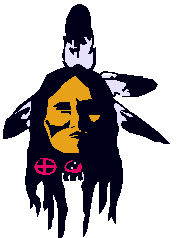
Official and Unofficial Tribal Sites
Reality of Native Nations and Tribal Websites
|
|---|

Reality of Native Nations and Tribal Websites
|
|---|
Because this page had not been updated since 1996, a great many sites either moved, no longer existed, changed from unofficial to offical, or made other major changes. The links to individual tribal sites have been removed from the listing below. Instead, we offer links to 2 other sites that are actively maintained:
We hope this is useful to you. Google will also be useful.
SEE | |
|---|---|
|
Bureau of Indian Affairs Not much content (compare with Canadian INAC), but here it is. To locate contact info (minimally just the tribal office general phone) you must go to the Area Offices page, and pick the Area Office which overviews the tribe you're seeking. CODETALK is another U.S. agency website that is developing significant content for tribal department, project, an d educational use.
|
INAC -- federal Indian and Northern Affairs, Canada. No longer provides database info on 600+ Canadian bands, but does list an 800 phone number. Nunavut Planning Commission -- While this is still a Canadian agency preparing for the transition of Nunavut to Province status in 1999, it now has a number of Inuit staffers, including a trainee-Executive Director. Most Inuit Board members are also on-line (with email) and can presumably overview the site. Also available are press releases, a map, newsletters. Canadian and English Native treaties Map windowed fulltexts, historical contexts. |
|
Anishinaabemowin Songs: By Gagandac, White Earth Reservation, around 1908 Naningodinunk Nibabacawendam Niyau Babamaciyan Gitchigoon Sometimes I go around feeling sorry for Myself While I'm being carried by the wind All around the sky. Misiwe Akin Nindebwewidum All over The world My voice resounds . . . But nobody ever sends me any money. Why is that, I wonder? Etaa Ningotan The wind Is the only thing That I'm afraid of
| |
Page |
SCHOOLS |
MENU |
|---|
CREDITS: The warrior image, in black and white, was used on many AIM and Wounded Knee Legal Defense flyers in 1973-75, by pasteup. It first appeared in a 1973 issue of Akwesasne Notes and was probably drawn by Rokwaho, Wolf Clan Mohawk, artist and poetry editor for Notes back then. California AIM uses it as a logo. I traced it in FreeHand several years ago, and colored and adapted it for this page. The Colibri (hummingbird) was a much large photo (or painting?) on the Taino InterTribal Council web gallery. I reduced and animated it. The poems are songs, recorded at White Earth in 1908 by Frances Densmore and published in Chippewa Songs Ross and Haines Old Books, 1972. Various song-poems will appear from time to time at the bottoms of the sites columns to even them up.
Last updated: 3/21/02 KMS